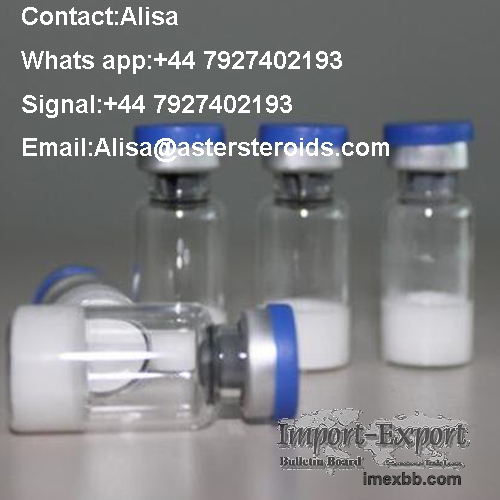 |
Home > Offers to Sell > Chemicals & Plastics > Other Chemicals > Other Chemicals
| Contact: | alisa |
|---|---|
| Company: | Astersteroids |
| hk | |
| hk | |
| United States | |
| E-Mail: | |
| Date/Time: | 4/29/24 1:52 GMT |
Neuropeptide Kisspeptin for sale with good quanity Activation of GnRH leads
https://www.astersteroids.com/neuropeptide-kisspep , tin-for-sale-with-good-
quanity-activation-of-g , nrh-leads-to-release-of-fsh-and-lh/
Neurope , ptide Kisspeptin
Cas:1848962-29-7
MF:C63H7 , 8N18O13 · xC2HF3O2
Purity:98% HPLC
Packing:2mg/vial and 5mg/vial;10vials/box
Min Order: 1box
Payment:Bitcoin,Moneygram and Wester Union
Lead time:24hours after received payment
Safe shipping to US and most of Europe country
Storage:Shading, confined preservation,2-8°C
What is Neuropeptide kisspeptin?
Neuropeptide Kisspeptin, also known as kiss1, was first identified in 1996
as a transfer suppressor in human cell lines.
The Kiss1 gene encodes a protein composed of 145 amino acids. In the human
body, this protein is processed into a 54-amino acid peptide called
kisspeptin, which, like several other neuropeptides, has a unique RF-amide
motifs in its C-terminal region. It binds and activates the G-protein-
coupled receptor GPR54, which stimulates hypothalamic neurons to release
GnRH, leading to pituitary gonadotropin (LH and FSH) and sex hormone
secretion.
Kisspeptin is a key regulator of the onset of puberty, regulation of sex
hormone-mediated gonadotropin secretion, and fertility control. Inactivated
or activated mutations in Kiss1 and GPR54 genes are associated with
hypogonadotropin hypogonadism (IHH) and precocious puberty (CPP).
Neuropeptide kisspeptin has three main functions
Activation of GnRH neurons in the hypothalamus leads to GnRH release, which
leads to the release of FSH and LH.
Inhibit the development of tumors.
Treat low libido.
How kisspeptin activates GnRH Neurons
Bodybuilder is all too familiar with HPTA, the hypothalamic-pituitary-
testicular axis whose positive and negative feedback controls the production
and cessation of testosterone in men. HPGA is the hypothalamic-pituitary-
gonadal axis. HPGA controls all stages of reproduction. The hypothalamus
produces GnRH into the anterior pituitary and stimulates the secretion of LH
and FSH. Slow GnRH pulsation is conducive to FSH secretion, while fast pulse
frequency supports LH secretion.
What is the hypothalamic-Pituitary-gonadal axis (HPGA)?
The positive and negative feedback of the hypothalamic-pituitary-gonadal
axis (HPGA) controls the secretion and cessation of sex hormones in both men
and women, and its normal work maintains the normal levels of sex hormones
in both men and women, thus maintaining physiological functions. This is
something that happens every day in the adult body, and HPGA plays an
important role in adult men and women. However, HPGA is not form in
adulthood; all its components are establish in the foetus, activate in the
neonatal period, then become stationary in childhood and cannot reactivate
until puberty.
GnRH Secretion Triggers Onset of Puberty
Hypothalamic gonadotropin-releasing hormone (GnRH) neurons are functional at
birth, but after a perinatal hormone surge, they are directly suppressed in
infancy and no longer function. Until puberty, dormant GnRH neurons are
awakened to rerelease GnRH. GnRH secreted by the hypothalamus drives the
pituitary gland to secrete the release of gonadotropin (follicle-stimulating
hormone FSH and luteinizing hormone LH).
In males, the increased release of GnRH pulses during puberty activates
gonadotropin secretion, which in turn leads to increased testosterone
secretion levels in the testis, binding with FSH to initiate
spermatogenesis. Tetanic LH secretion consists of intermittent episodes of
hormone secretion that reflect the corresponding pattern of pulsing GnRH
release in the hypothalamus.
In women, increased impulsive GnRH release also drives gonadotropin
secretion, which is responsible for follicular formation and estradiol (E2)
secretion.
After puberty is complete, HPGA is officially complete and functional.
Puberty begins through increase production of GnRH, however, it remains an
open question how GnRH neurons activate during puberty.
Neuropeptide Kisspeptin controls GnRH pulse Production
Subsequent 15 years of research have shown that hypothalamic kisspeptin acts
upstream of GnRH and mediates sex hormone feedback and metabolism on the
reproductive axis. This neuropeptide is necessary to start puberty and
maintain normal reproductive function,
Minimum Order: 10 grams
SOURCE: Import-Export Bulletin Board (https://www.imexbb.com/)
Similar Products:Not exactly what you are looking for? Post an Offer to Buy!
![]()
© 1996-2010 IMEXBB.com. All rights reserved.
|
|
|






